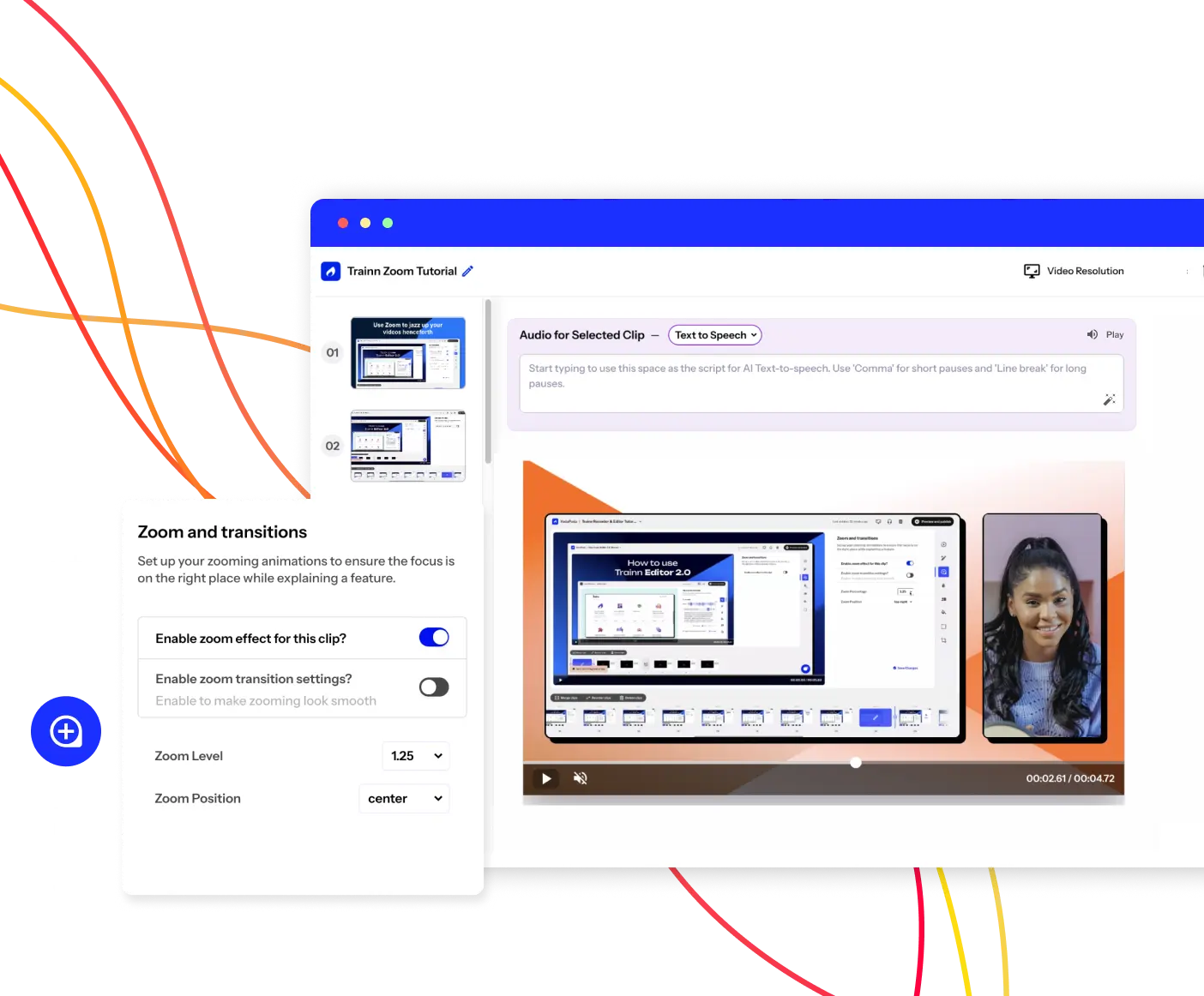- Features
- Resources
- Pricing
Create Stunning Product Videos with AI
Meet Trainn: An AI-powered video creation tool to create videos of your digital product in 5 minutes and at scale.
Free for 14-days. No credit card required.
Related terms
Text-to-Speech Video
What is a Text-to-Speech Video?
A text-to-speech video is a type of video content where text-based content is converted into spoken audio using text-to-speech (TTS) technology. Instead of using human voiceovers or narration, text-to-speech videos rely on synthesized voices to convey information to the viewer. These videos often include visual elements such as on-screen text, graphics, and animations to complement the audio and enhance comprehension.
Benefits of Using a Text-to-Speech Video
Text-to-speech videos offer a range of benefits for creators and viewers alike. Some key advantages include:
- Time and Cost Efficiency-Text-to-speech videos eliminate the need for human voiceovers, reducing production time and costs associated with hiring voice talent.
- Scalability-With text-to-speech technology, creators can generate audio for large volumes of text content quickly and easily, making it ideal for projects with tight deadlines or extensive content requirements.
- Multilingual Support-Text-to-speech technology supports multiple languages and accents, allowing creators to reach a global audience without the need for multiple voice actors or translations. Read why content localization is the secret element that will elevate your videos’ performance.
- Accessibility-Text-to-speech videos provide an accessible format for viewers with visual impairments or language barriers, enabling them to access and understand the content more easily.
- Efficiency-Text-to-speech videos streamline the video creation process by automating the audio production, allowing creators to focus on other aspects of content creation.
- Consistency-Text-to-speech technology ensures pronunciation and tone across all videos, maintaining a uniform brand voice and style.
How do Text to Speech Videos Work?
Text-to-speech videos work by converting written text into spoken audio using specialized software or platforms. This process involves the use of text-to-speech (TTS) technology, which employs computer algorithms to analyze the text and generate corresponding speech output. Once the text is inputted into the text-to-speech software, it undergoes linguistic analysis to determine pronunciation, intonation, and other linguistic features. The software then synthesizes the speech using digital recordings of human speech sounds or by generating speech waveform signals from scratch. The resulting audio is synchronized with visual elements such as on-screen text, graphics, and animations to create a cohesive video presentation. Text-to-speech videos offer a convenient and efficient way to produce audio content, particularly for projects with large volumes of text or tight deadlines.
What are the Types of Text-to-Speech Video?
There are several types of text-to-speech videos, each serving different purposes and audiences. Some common types include:
- Educational Videos - Text-to-speech technology is commonly used in educational videos to provide spoken explanations of complex concepts or readings, helping students better understand the material.
- Tutorial Videos - Tutorial videos often utilize text-to-speech technology to provide step-by-step instructions or explanations for completing tasks or processes, making them accessible to viewers with varying levels of literacy. This blog convinces you why text-to-speech converters will revolutionize customer training.
- Accessibility Videos - Text-to-speech videos are also used to create accessible content for viewers with visual impairments or reading difficulties, providing spoken audio descriptions of visual elements in the video.
What are the Challenges of Creating a Text-to-Speech Video?
While text-to-speech videos offer numerous benefits, they also present some challenges for creators, including:
- Naturalness - Synthetic voices generated by text-to-speech technology may lack the naturalness and expressiveness of human voices, potentially impacting viewer engagement and comprehension.
- Pronunciation - Text-to-speech algorithms may struggle with correctly pronouncing certain words or phrases, particularly names, acronyms, and technical terms, requiring manual editing or adjustments.
- Tone and Emotion - Synthetic voices may struggle to convey the appropriate tone and emotion for certain types of content, such as marketing videos or storytelling narratives, requiring careful selection of voice settings and customization.
Here is a blog that delves into the argument of whether the future is AI voiceovers or human voices.
How to Select the Right Tool for Creating Text-to-Speech Video?
Choosing the right tool for creating text-to-speech videos is essential for achieving optimal results. Consider the following factors when selecting a tool:
- Voice Quality - Look for text-to-speech software or platforms that offer high-quality, natural-sounding voices with a range of accents and languages to choose from.
- Customization Options - Evaluate the customization options available for adjusting voice settings, pronunciation, and intonation to suit your specific needs and preferences.
- Integration - Consider how the text-to-speech tool integrates with your existing video creation workflow, including compatibility with video editing software, file formats, and export options.
- Accessibility Features - If creating accessible content is a priority, choose a text-to-speech tool that includes features for adding audio descriptions, captions, and other accessibility enhancements.
Platforms like Trainn stands as the ultimate solution for revolutionizing your video creation process with its built-in text-to-speech converter. With Trainn, you have the power to transform written content into engaging audiovisual experiences that captivate and inform your audience. The best part - you can select from 100+ AI voiceovers and 20+ languages.
FAQs
Can text-to-speech videos be used for commercial purposes?
Yes, text-to-speech videos can be used for commercial purposes, such as marketing, advertising, training, and more. Many businesses and organizations leverage text-to-speech technology to create cost-effective and scalable video content for their audiences.
Are there limitations to text-to-speech technology?
While text-to-speech technology has improved significantly in recent years, there are still some limitations to consider, such as pronunciation errors, lack of naturalness in synthetic voices, and difficulty conveying emotion or nuance in speech.
How can I ensure the accuracy of the text-to-speech audio?
To ensure the accuracy of the text-to-speech audio, it's important to carefully proofread the text content before generating the audio. Additionally, some text-to-speech tools offer options for manual editing or adjustments to correct pronunciation errors or improve the naturalness of the speech.






